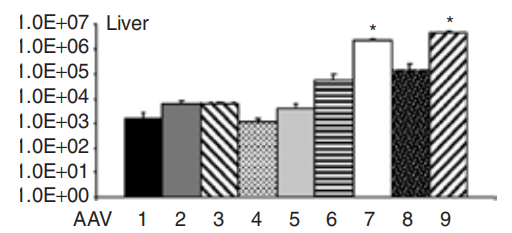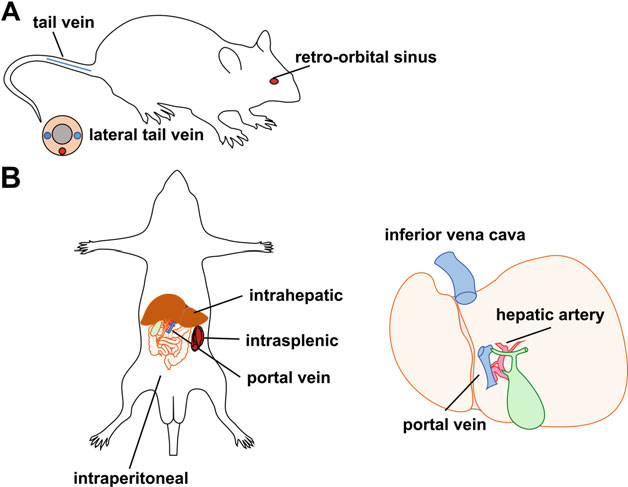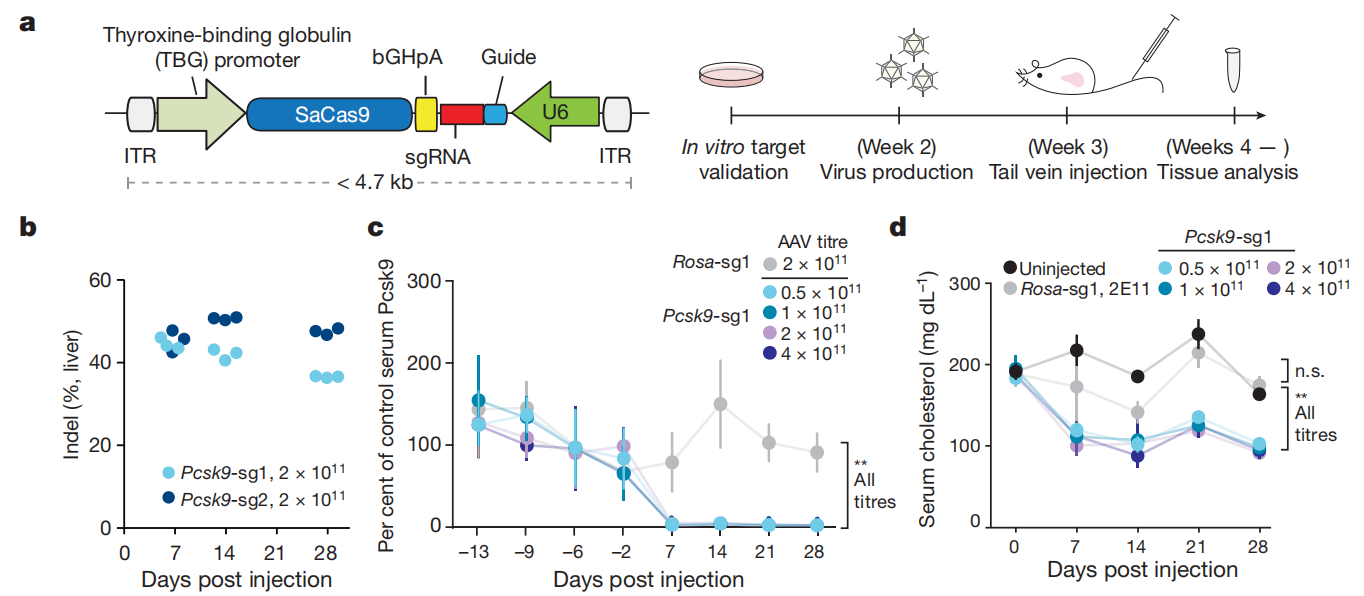- E-mail:BD@ebraincase.com
- Tel:+8618971215294
Adeno-associated virus (AAV) vector-mediated gene therapy is considered a safe, efficient, and highly promising method for liver gene transfer. Significant therapeutic effects have been achieved with liver-targeted AAV gene therapy in patients with hemophilia A and B, and an increasing number of clinical trials have confirmed its efficacy. By using intraportal or intravenous injection, the highly infectious AAV is utilized to deliver the target gene into liver cells, enabling gene expression. Choosing the appropriate AAV serotype and liver-specific promoter can achieve stable transfection of liver cells and ensure effective expression of the exogenous gene in the bloodstream and target tissues.
AAV8 can cross the barrier present between endothelial cells and blood vessels to transduce liver tissue and cells. Compared to other AAV serotypes, AAV8 exhibits an enhanced transduction efficiency in the liver by 10 to 100 times. AAV7, AAV9, and AAV-DJ are also suitable for liver research.

Figure 1: Expression of Different Serotypes in the Liver

In liver-targeted AAV gene transfer, the route of vector administration does influence the transduction efficiency of hepatocytes; however, this is also affected by other factors such as the capsid serotype and genomic configuration. The following sections will introduce the most commonly used administration routes in small animal, large animal, and human models (see Figure 2), and provide guidance for selecting the optimal administration route to achieve the desired experimental outcomes.

Figure 2: Schematic Diagram of Common Liver Injection Methods

Downregulation of Hepatic sEH Induces Antidepressant-like Effects
Vector: AAV2/8-CMV-eGFP-H1-Ephx2-shRNA1
Promoters: CMV, H1
Experimental Animal: CMS mice (chronic stress model)
Injection Method: Tail vein injection, 1x10^11 vg/mouse
Experimental Results: To determine whether downregulation of hepatic sEH induces antidepressant-like effects, AAV8 virus was delivered via tail vein injection, introducing shRNA fragments that interfere with the target gene into the mice, specifically targeting the liver to achieve downregulation of sEH in hepatocytes. The results indicate that hepatic sEH may play an important role in the pathophysiological processes of depression.

Figure 3: Downregulation of Hepatic sEH Induces Antidepressant-like Effects
AAV8-Mediated In Vivo Expression of SaCas9 and Its sgRNA
Vector: AAV2/8-TBG-SaCas9-bGH polyA-U6-sgRNA (Pcsk9)
Promoter: TBG
Experimental Animal: C57 mice
Injection Method: Tail vein injection, 1x10^11 vg/mouse, expressed for 4 weeks
Experimental Results: The sgRNA targeting Pcsk9 and SaCas9 were constructed on the same AAV vector for viral packaging. After injecting the AAV virus into the mice via tail vein injection, over 40% indel formation was observed at every site throughout the liver tissue one week post-administration (where "Indel" stands for "insertion and deletion," referring to insertions or deletions that occur in the genome relative to the reference sequence. By detecting these indels, researchers can assess the efficiency and accuracy of gene editing). The levels remained similar at two and four weeks post-injection. To determine the effect of different AAV doses targeting Pcsk9-SaCas9 on serum Pcsk9 and total cholesterol levels, various AAV doses were administered. One week after injection, serum Pcsk9 levels decreased by 95%, and total cholesterol levels decreased by 40%, with these effects persisting for four weeks.

Figure 4: AAV-Mediated SaCas9 for Liver Genome Editing
AAV8-Mediated Expression of St1Cas9-Hpd Corrects the Phenotype in a Genetic Type I Tyrosinemia Model Mouse
Vector: AAV2/8-LP1B-St1Cas9 Hpd G5
Promoter: LP1B
Experimental Animal: Fah-/- neonate mice (liver injury model)
Injection Method: Retro-orbital vein injection, 5x10^10 vg - 1x10^11 vg/mouse, expressed for 4 weeks
Experimental Results: To deliver St1Cas9 targeting exon 13 of the Hpd gene to the liver, the liver-specific serotype AAV8 and the specific promoter LP1B were chosen to construct the vector and package the virus. The virus was injected into the neonatal mice via retro-orbital vein injection, and liver tissue was collected for quantitative analysis 28 days post-injection.

Figure 5: AAV-Mediated St1Cas9 for Liver Genome Editing
Example 4
Let-7 Alleviates CCl4-Induced Liver Fibrosis
Vector: AAV2/8-vec and AAV2/8-let-7a
Experimental Animal: CCl4 mice (liver fibrosis model)
Injection Method: Tail vein injection, once a week, 2x10^10 vg/mouse, expressed for 3 weeks
Experimental Results: Let-7 expression is reduced in the livers of patients with liver fibrosis and in rodent models. Given the newly discovered mechanism of let-7, the authors tested its potential therapeutic effects in two commonly used liver fibrosis mouse models. The results indicate that Let-7 may effectively alleviate CCl4-induced liver fibrosis by simultaneously targeting TET3/TGF-β and Fas-mediated pathways in hepatocytes.

Figure 6: Effects of Let-7 on CCl4-Induced Liver Fibrosis Model
References
1、Zincarelli C, Soltys S, Rengo G, Rabinowitz JE. Analysis of AAV serotypes 1-9 mediated gene expression and tropism in mice after systemic injection. Mol Ther. 2008;16(6):1073-1080.
2、Palaschak B, Herzog RW, Markusic DM. AAV-Mediated Gene Delivery to the Liver: Overview of Current Technologies and Methods. Methods Mol Biol. 2019;1950:333-360.
3、Qin XH, Wu Z, Dong JH, et al. Liver Soluble Epoxide Hydrolase Regulates Behavioral and Cellular Effects of Chronic Stress. Cell Rep. 2019;29(10):3223-3234.
4、Ran FA, Cong L, Yan WX, et al. In vivo genome editing using Staphylococcus aureus Cas9. Nature. 2015;520(7546):186-191.
5、Agudelo D, Carter S, Velimirovic M, et al. Versatile and robust genome editing with Streptococcus thermophilus CRISPR1-Cas9. Genome Res. 2020;30(1):107-117.
6、Song J, Lv H, Liu B, et al. Let-7 suppresses liver fibrosis by inhibiting hepatocyte apoptosis and TGF-β production. Mol Metab. 2023;78:101828.
Brain Case offers customized services for viral packaging. please refer to our vectors library or email BD@ebraincase.com to discuss details with our technical experts